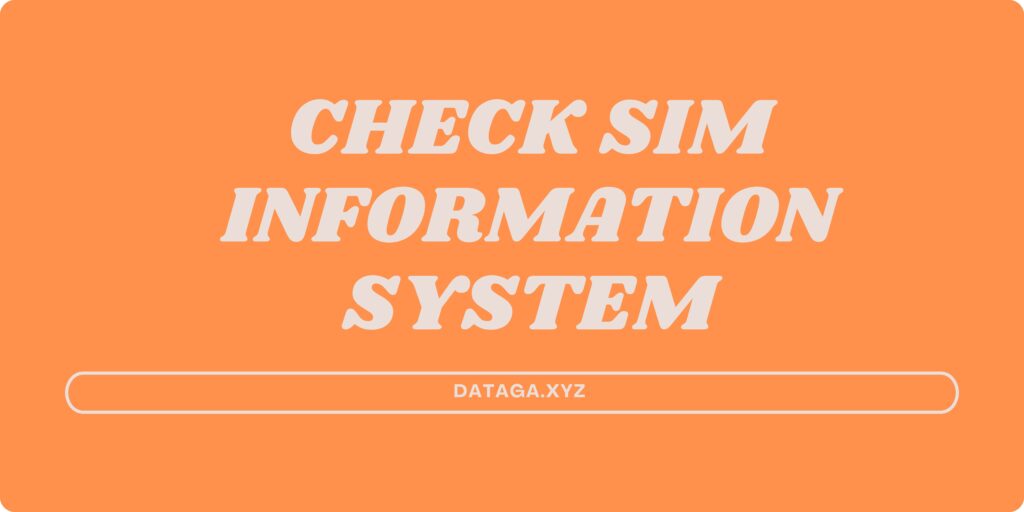Whether you are looking to verify your SIM information system, check its registration status, or get more insight into your mobile number, understanding how to check sim information system is vital for a smooth mobile experience. From connecting with family and friends to managing our finances and accessing online services, our mobile numbers play a huge role. However, it is not always easy to know where your SIM card stands in terms of its registration, ownership, and associated details.

Why Should You Check SIM Information?
You might wonder, Why is it important to check SIM information? There are several reasons why you might need to check your SIM card’s details:
- Verify Registration: It is crucial to know if your SIM is registered correctly under your name, especially to avoid fraud or other issues.
- Track Ownership: In case you lose your phone or if you are buying a second-hand phone, knowing the SIM card’s ownership can be a lifesaver.
- Solve Network Issues: If you’re facing network connectivity problems, checking your SIM’s information might provide insight into whether your SIM card needs an update or if there’s an issue with the network provider.
- Prevent Unauthorized Usage: Checking the information helps you confirm whether the SIM is still active or if any suspicious activities have occurred.
Now that we understand the importance of checking SIM information, let’s look at how to go about it.
How to Check SIM Information
There are several methods available to check sim information system. Some methods are more straightforward than others, but each is effective in providing the necessary details. Here are some of the most common ways to check SIM information:
- Also Read This: How to check pak sim data
1. Check sim information system Using USSD Codes
USSD (Unstructured Supplementary Service Data) codes are one of the easiest ways to check your SIM card information. These short codes can be dialed directly from your phone’s dialer to get information about your SIM card, including your account balance, registration details, and more. Telecom providers across the globe offer different USSD codes for customers to check their SIM information.
- For example: In India, you can dial *121# to check your account details and SIM card status.
- Similarly, in Pakistan, dialing *336# can help you access details about your SIM card registration.
Each telecom provider has different USSD codes, so it is a good idea to check your provider’s official website or customer service for the correct code to check your SIM details.
2. Using Your Telecom Provider’s Website or App
Many telecom companies offer user-friendly apps and websites that allow you to access detailed information about your sim information system. These platforms often provide a comprehensive overview of your account, including your SIM card’s registration status, plan, and even usage details.
Here’s how to check your SIM card information through a telecom provider’s app or website:
- Download the App: Most providers have official apps for iOS and Android devices. For instance, My Airtel (India), My Vodafone (UK), and My T-Mobile (USA) are examples of apps that let users check SIM information.
- Log Into Your Account: Once you have installed the app, sign in with your mobile number or account credentials.
- Access SIM Information: Inside the app or website, look for sections related to your SIM registration, account settings, or profile to check your SIM details.
The benefit of using these apps is that they also allow you to manage your account, recharge your SIM, change your plan, and check your usage history.
- Also Read This: SIM Owner Details
3. Calling Customer Service
If you prefer speaking to a representative, you can always call your mobile provider’s customer service helpline to check your sim information system. Customer service agents can provide details about your SIM registration, account status, and resolve any issues you might face.
When calling customer support:
- Provide Your SIM Number: Be ready to share your SIM number or mobile number to help the representative locate your details quickly.
- Have Your ID Ready: In some cases, customer support may ask you for identification to verify that you are the legitimate owner of the SIM card.
4. Visiting a Telecom Store
If you are unable to check sim information system online or via phone, you can visit a physical store or service center of your telecom provider. The customer service team at the store will be able to help you check your SIM card details.
- Bring Valid Identification: When you visit a store, ensure you bring a government-issued ID to verify your identity.
- Request SIM Details: Once your identity is confirmed, the representative will pull up the registration details of your SIM.
Visiting a store can also be a great option if you have complex issues, such as needing a replacement SIM or resolving a technical problem with your account.
5. Using SMS Services
In some regions, telecom companies provide SMS services that allow you to check your sim information system registration status or other important information. This is another quick and simple method to access SIM details without needing to call or visit a store.
For instance:
- India: You can send an SMS to 121 to get a quick overview of your account details.
- Pakistan: A similar service is available, where you can send an SMS to a particular number to check your SIM card’s information.
Check with your telecom provider to see if they offer this service and the exact SMS codes you should use.
Key Information You Can Check for Your SIM Card
When checking your sim information system, you will typically be able to access the following details:
- SIM Registration: Confirm whether the SIM is registered under your name.
- Account Information: Find out about your mobile plan, balance, data usage, and billing cycle.
- SIM Number: The number associated with the SIM, often displayed on the packaging or on the SIM card itself.
- Activation Status: Whether the SIM is active or if there are any issues with its activation.
- Carrier Information: The telecom provider associated with your SIM card and any associated network issues.
- Personal Details: Some telecom providers allow you to update or view your personal details associated with the SIM card.
Why It is Important to Regularly Check Your SIM Information
While it might seem like an unnecessary task, regularly checking your sim information system is a good habit for several reasons:
- Preventing Unauthorized Usage: If someone has gained unauthorized access to your SIM, regularly checking can help you spot it early and prevent further issues.
- Security and Fraud Protection: By ensuring your SIM is registered correctly and linked to your account, you avoid the risk of identity theft or fraud.
- Network Connectivity Issues: If you are experiencing network problems, checking your SIM details can help you identify if there’s an issue with your SIM card or if it needs to be replaced.
- Stay Informed: You will be aware of any changes to your mobile account, such as new charges, changes in plans, or any other important updates.
Common FAQs:
How can I check the ownership of my SIM card?
You can check the ownership of your SIM card by logging into your provider’s website or app, calling customer service, or visiting a store. They will confirm whether the SIM is registered under your name.
Can I check if my SIM is registered online?
Yes, most telecom providers allow you to check if your SIM is registered through their websites or mobile apps.
How do I know if my SIM is active?
You can check the activation status by calling customer service, using a USSD code, or checking through your telecom provider’s app.
Final Thoughts
Checking SIM information is essential for managing your mobile account and ensuring everything is in order. Whether you need to verify your SIM registration, track your usage, or resolve issues, there are plenty of ways to access your SIM card details. Make sure you regularly check your SIM information to avoid security issues and ensure your mobile experience remains smooth and hassle-free.
Also Read This: Dataga


